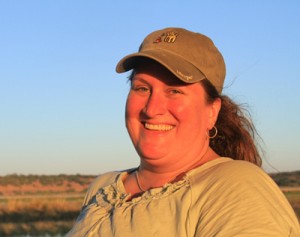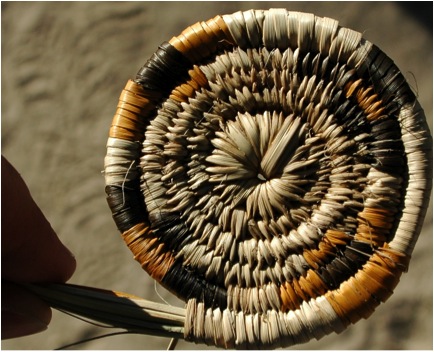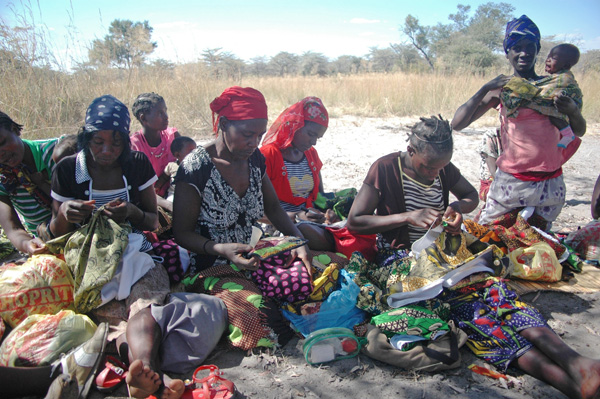Community Conservation: Weaving & Leading
EWB is happy to welcome Dr. Rachel DeMotts back to Kasane. Dr DeMotts is Mellon Associate Professor of Global Environmental Politics at the University of Puget Sound in Tacoma, Washington [pugetsound.edu] and a former Research Fellow at the University of Botswana’s Okavango Research Institute. For the past two years she has brought a group of students to Botswana to assist EWB with wildlife counts in Chobe National Park [“From hard to hardest in a game count,” DeMotts and Chase, Zambezi Traveller]. Dr. DeMotts is currently on a year long sabbatical from Puget Sound, and will be in Kasane, Maun, and Katima Mulilo until June. See blogs written by visiting students from University of Puget Sound: “Elephant Herd Assessments by Puget Sound Students, EWB & University of Puget Sound Field School Expedition
With a grant from EWB supported by the Paul G. Allen Family Foundation, Dr. DeMotts will work on two projects in the coming months. Her primary interest is in the gendered dimensions of community-based conservation – in particular, women who weave baskets to sell to tourists, and the ways in which they might benefit from such activity. This work is important because women are often missing from the southern African conservation picture. The tendency to focus on wildlife often makes conservation a man’s endeavor, because in cultural terms hunting and dealing with wildlife remain jobs for men. At the same time, women define their own spaces for participation – for example, through the harvest of forest resources for craftmaking. Crafts provide crucial access to cash, which is often used to pay school fees for children – and in many cases, that child is a girl who otherwise might not have been able to attend school. The opportunity to participate in the craft markets also creates gendered social spaces for women where problems like HIV/AIDS can be discussed, and leadership skills develop.
This project will contribute a gendered view to discussions of the local impacts of community conservation, which have all but been ignored to this point. In addition to being important for local women and their livelihoods, these considerations are also crucial as transfrontier conservation initiatives such as the KAZA TFCA, seek to scale up.
In this context, Dr. DeMotts argues that women’s voices must be heard in these processes if they are to bring benefits to the local level and not merely create more opportunities for tourist safaris.
Dr. DeMotts’ second project focuses on increasing human-elephant conflict in Kazungula, the peri-urban area just outside of Kasane. As increasing numbers of elephants pass through local village areas to reach the Chobe River, local residents struggle to manage living with the pressures of nearby wildlife. To better understand the changing interactions between people and elephants, Dr. DeMotts will conduct participatory research in village areas along the corridors used by elephants to reach the river. This work will offer a fuller picture of ways in which the movement and behavior of elephants and people in the area are changing, and hopefully offer insights for strategies to help alleviate local problems. It also builds on recent work that Dr. DeMotts published in collaboration with Dr. Parakh Hoon of Virginia Tech that examined the hidden costs of human-elephant conflict in Ngamiland, suggesting that a fuller understanding of who is most affected by living with elephants – and how – is crucial to creating better policies (“Whose Elephants? Conserving, Compensating, and Competing in Northern Botswana,” DeMotts and Hoon, http://www.tandfonline.com/doi/abs/10.1080/08941920.2011.638362].
Good luck, Dr. DeMotts, we are glad to have you with us! We look forward to hearing and sharing all about what you find out.
To learn more about EWB projects, visit our website http://www.elephantswithoutborders.org/
To support us (thank you in advance) http://www.elephantswithoutborders.org/donate.php
Or follow us on Facebook https://www.facebook.com/elephantswithoutborders
Tags: africa, botswana, community, conservation, education, elephants, elephants without borders, gender, human-elephant conflict, Namibia, people, research











While we are beginning to understand the symbiotic relationships between the graziers flora insects etc, we must never forget to include the population and workers in our Holistic management of the remaining wildlife reservoirs.